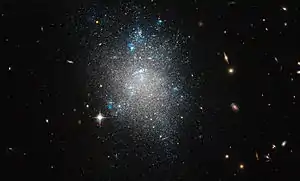| NGC 5477 | |
|---|---|
 Dwarf galaxy NGC 5477 taken by the Hubble Space Telescope. | |
| Observation data (J2000 epoch) | |
| Constellation | Ursa Major[1] |
| Right ascension | 14h 05m 33.1s[2] |
| Declination | +54° 27′ 40″[2] |
| Redshift | 0.001057[2] |
| Heliocentric radial velocity | 317 km/s[2] |
| Distance | 20 million light years[1] |
| Apparent magnitude (V) | 14.01[2] |
| Characteristics | |
| Type | Sm:[3] |
| Other designations | |
| MCG+09-23-034, VV 561, [MI94] Sm 95, DDO 186, SPB 245, Z 272-25 [VDD93] 194, IRAS F14038+5441, TC 305, Z 1403.8+5442, KUG 1403+546, UGC 9018, [HBS84] 74, LEDA 50262, UZC J140532.8+542739, [M98c] 140347.9+544200[2] | |
NGC 5477 is a dwarf galaxy located in the constellation of Ursa Major, 20 million light years away from Earth. It was discovered on April 14, 1789 by the astronomer William Herschel.[3]
References
- 1 2 "An archetypal dwarf galaxy". Picture of the Week. ESA/Hubble. Retrieved 11 January 2013.
- 1 2 3 4 5 6 "Search Results for 5477". Astronomical Database. SIMBAD. Retrieved 11 January 2013.
- 1 2 Seligman, Courtney. "New General Catalogue objects: NGC 5450 - 5499". cseligman.com. Retrieved 2021-02-27.
External links
 Media related to NGC 5477 at Wikimedia Commons
Media related to NGC 5477 at Wikimedia Commons
This article is issued from Wikipedia. The text is licensed under Creative Commons - Attribution - Sharealike. Additional terms may apply for the media files.